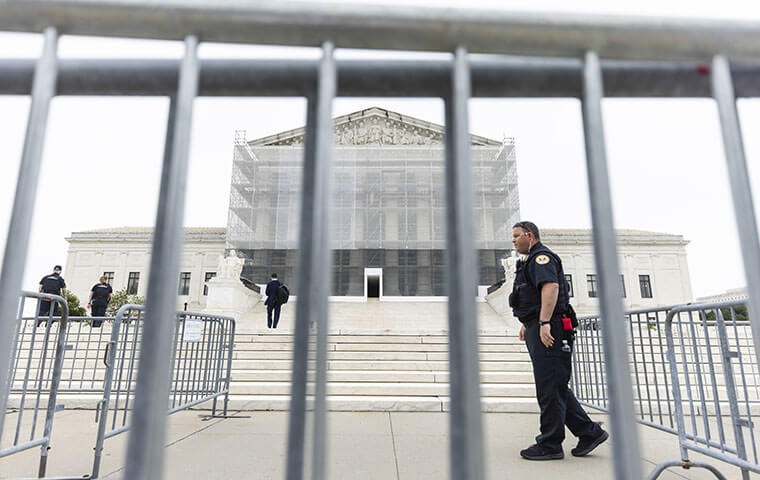 Police gather outside the US Supreme Court as the high judges prepare to issue decisions on birthright citizenship, along with five other cases, in Washington, DC, USA, 27 June 2025. Birthright citizenship, which is guaranteed by the Fourteenth Amendment to the Constitution, grants citizenship to all babies born in the United States, regardless of their parents' legal status. Image: JIM LO SCALZO/EPA/Shutterstock
By: FEDweek Staff
Police gather outside the US Supreme Court as the high judges prepare to issue decisions on birthright citizenship, along with five other cases, in Washington, DC, USA, 27 June 2025. Birthright citizenship, which is guaranteed by the Fourteenth Amendment to the Constitution, grants citizenship to all babies born in the United States, regardless of their parents' legal status. Image: JIM LO SCALZO/EPA/Shutterstock
By: FEDweek StaffThe Supreme Court has ruled to allow Trump’s executive order on mass reductions-in-force (RIFs) to move forward. The ruling effectively lifts prior injunctions that had stalled agency actions and removes a major legal barrier to the administration’s workforce overhaul.
The court recently issued a decision limiting the discretion of lower courts to issue nationwide injunctions. That ruling seemed to leave more leeway in cases involving the Administrative Procedure Act – affecting federal employees more broadly, but has now sided with the White House’s challenge to the injunction.
“This is an important ruling for the current administration as it provides the green light to continue with planned Agency reorganizations and reductions in force. However, the distinction made here is that the language of the EO states that these actions are consistent with applicable law,” said Ryan Nerney, managing partner at Tully Rinckey PLLC. “Therefore, while SCOTUS’s ruling lifts the injunction, it leaves the door open for individual cases to challenge if the action plans and reorganizations are ‘consistent with applicable law’.”
WH Touts Reductions on FedScope
Meanwhile, OPM said “hundreds of thousands” of federal employees accepted deferred resignation offers while confirming that “tens of thousands” are facing layoffs in pending RIFs.
OPM made that statement in the first—although not exact—accounting of the government-wide impact of those offers, and touted a reduction in the federal employee count on its FedScope site to just under 2.29 million through March, down by some 23,000 from last September.
“In addition, hundreds of thousands more workers will drop off the rolls in October 2025, when workers depart the federal government as part of the Deferred Resignation Program; and tens of thousands of employees who have received reduction-in-force or termination notices remain on government payrolls due to court orders that the administration is now challenging,” the OPM said prior to Tuesday’s SCOTUS decision siding with the White House.
The initial “fork in the road” deferred resignation offer in late January stirred controversy and lawsuits over its legality—including its promise to keep employees on paid administrative leave through as long as September 30, contrary to policy on that form of leave. Many agencies later made similar offers as they prepared to comply with a White House directive to prepare for substantial RIFs and reorganizations.
Some employees who accepted offers reported that their agencies had kept them on the job beyond when they had been promised, although by now all, or nearly all, already are out of the workplace.
OPM did not respond to a request for a more exact accounting.
Even a total acceptance of 200,000—the lowest possible number qualifying as hundreds of thousands—would constitute nearly 9 percent of the federal workforce.
Presumably, many of them will be retiring in September when their deferred resignation periods end, although in some cases employees apparently will be allowed to retire as late as the turn of the year. At any one time, about 15 percent of federal employees are eligible to retire under even standard rules.
OPM largely attributed the 23,000-position reduction to the impact of a general hiring freeze in effect since the outset of the Trump administration. In the first accounting of the freeze’s impact, OPM said it has reduced hiring from an average of about 23,000 a month to about 7,400. That hiring freeze has just been extended by three months to Oct. 15.
The six-month period for the reduction includes the annual surge in retirements that occurs around the turn of the year for reasons including maximizing the potential payout from the lump-sum payment at separation for unused annual leave. Also in February, agencies acted to lay off tens of thousands of probationary employees, although a court order blocked those layoffs and ordered most reinstated; some have been formally rehired while others are in limbo.
*The FedScope data exclude Postal Service employees and employees of intelligence agencies.
Large Share of Federal Workforce about to Experience a Payless Pay Period
OPM Details Coverage Changes, Plan Dropouts for FEHB/PSHB in 2026
OMB Says Federal Workforce RIFs are Starting as Shutdown Drags On
Financial Impact of Shutdown Starts to Hit Home; WH Threatens No Back Pay
Surge of Retirement Applications Is in the Pipeline, Says OPM
See also,
TSP Takes Step toward Upcoming In-Plan Roth Conversions
5 Steps to Protect Your Federal Job During the Shutdown
Over 30K TSP Accounts Have Crossed the Million Mark in 2025
The Best Ages for Federal Employees to Retire

